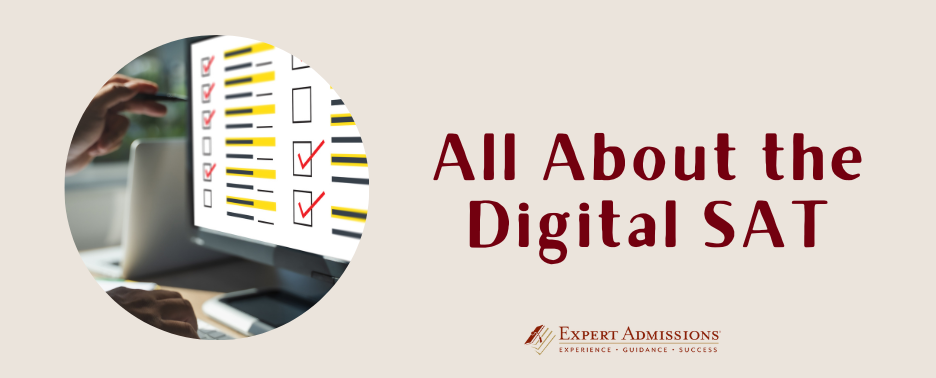
In 2022, the College Board announced that the SAT will be a fully digital two-hour test starting March of 2024. The decision was made after successful pilot runs that were conducted in November 2021, where 80% of students said they found the digital test less stressful when provided with tablets or laptops.
If you’re taking the SAT in the new format, you may be wondering what has changed, what remains the same and how to ensure that you find success with the new format.
What’s New and What Stays?
The biggest change to the SAT is the new adaptive format: each section of the SAT will have two modules, and the modules are adaptive—how a student performs on the first module will affect what they’ll be given in the second module. Students can take the test on their personal laptops. The new SAT app also introduces built-in features such as a calculator and annotation tools. Test-takers can bring paper and pencil to the testing center so that they can work on solving problems by hand before answering questions on their laptop.
The following will remain the same as the paper SAT:
- The digital SAT will be scored on a 1600 scale.
- The digital SAT will still be administered in a school or in a test center with a proctor present—not at home.
- Students can access practice tests and resources that will reflect the digital format. Although there are currently only four practice tests available right now, the College Board will release more tests and materials over time.
- Students who require disability accommodations will continue receiving them.
Superscoring
Superscoring is the practice of mixing and matching the best results from multiple test dates to get one superscore. How will superscoring work with this SAT transition? It’s not yet clear whether students will be able to superscore previous scores from the paper SAT with the results from the new digital SAT, and colleges have not made any statements on this yet. It is best to take the SAT with the assumption that it will not be superscored and to try your hardest to succeed in all sections of the digital format, regardless of your previous scores.
How to Prepare for the Digital SAT
Create a Study Plan
Just like the regular SAT, the electronic version of the test shouldn’t just be taken on a whim. Don’t try to cram everything at the last minute. Once you know when you’ll be taking the test, number one on our list of digital SAT tips is creating a study plan. Allot as much time as you need to the specific sections, making sure you’ll have enough time to go over everything. You can also work with your friends, make study groups, and share flashcards and other study resources.
Take Timed Practice Tests
The SAT will now be a total of 2 hours instead of 3 hours. When taking practice tests, time yourself to make sure you won’t be caught off guard at the actual testing center. You should not only adjust your practice tests to match the new time limit, but you should also mentally prepare yourself to take the test in a room surrounded by other students.
Familiarize Yourself with Testing Devices
Gone are the days of the Number 2 pencils and shading in little circles. When you start studying for the test, there’s no need to sit down with a pen and paper. Of course, they’re helpful when you’re writing down notes and learning the material, but when you take the actual test, it will help to be familiar with the actual testing device.
Take Advantage of the Calculator
One of the new updates the College Board has made to the digital SAT is that students can now use a calculator throughout the entire math section. You can also take advantage of the graphing calculator built directly into the testing app. Make sure you take advantage of these! Using a calculator can actually help you with time management and simplify the test-taking process.
Read—Outside the Classroom As Well
Another change the College Board has announced for the digital SAT is that the reading section will have passages that are more relevant to college-level reading. If you’re not much of a reader, it’s time to step up your game. This is a great time to expand your vocabulary and range of reading materialsStart by searching “college syllabus books” or “college reading list” on Google so you can gain a sense of what kind of books you should be reading.
Don’t Forget to Prioritize Rest
The brain can get very overwhelmed if you constantly try to input vocabulary and formulae without taking a pause. It’s important that you set aside time to eat all your meals, take a walk outside, and get plenty of sleep while you study for the SAT.
We highly recommend taking diagnostic tests for both the SAT and the ACT before deciding which one to pursue. If you do decide that the SAT is the right exam for you, see how you perform on practice tests before deciding when to sit for the actual test. With the right preparation, you’ll find the methods will allow you to succeed!
Leave a Reply